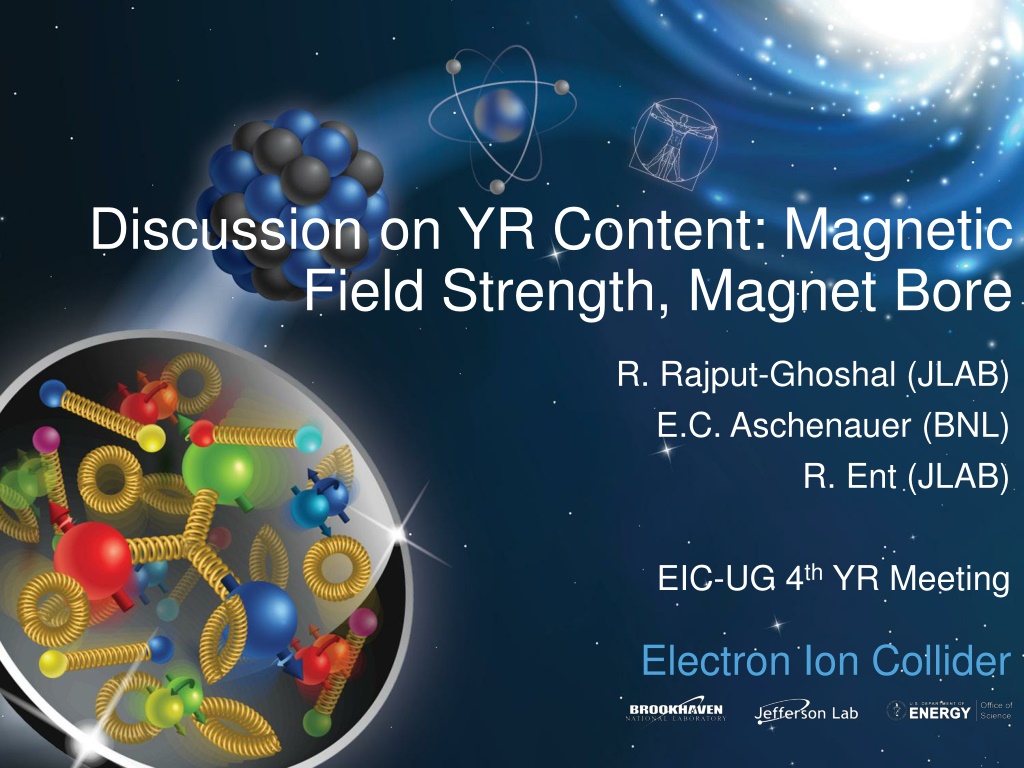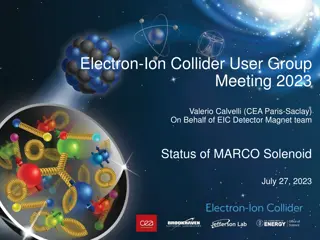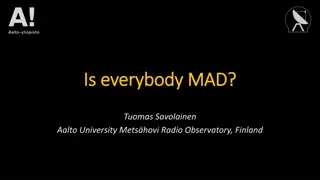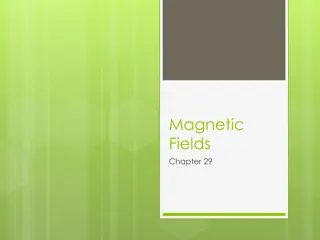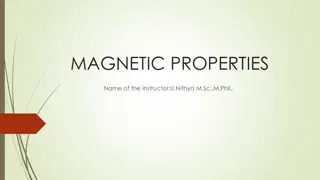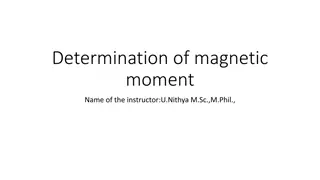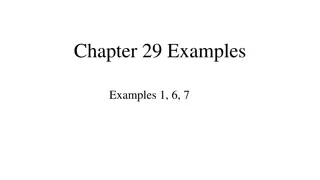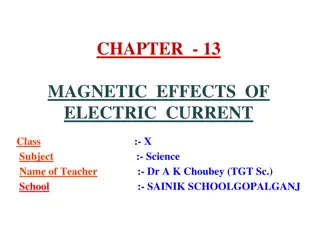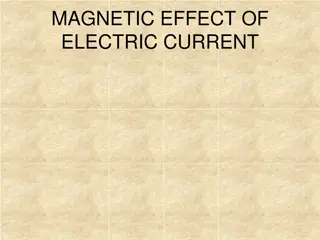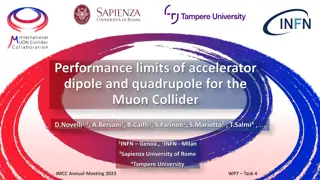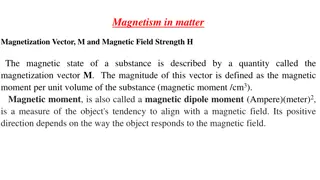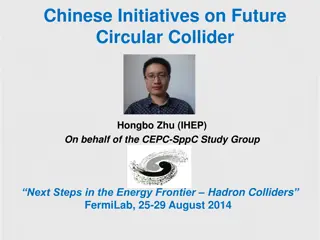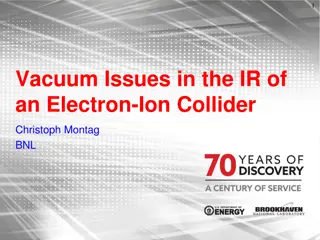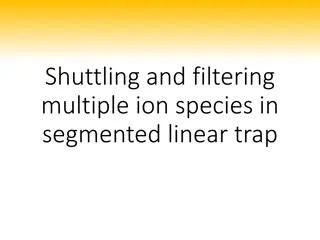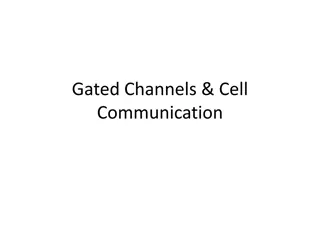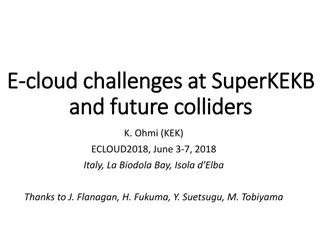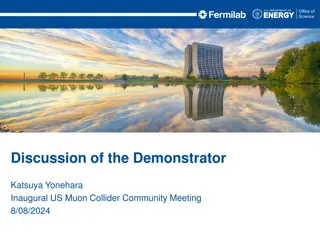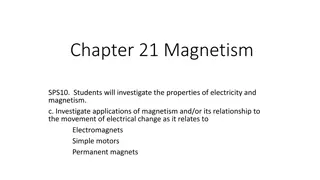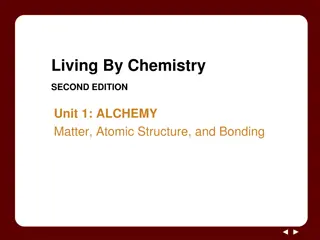Insights on Magnetic Field Strength for Electron Ion Collider
Discussion on the requirements and advantages of different magnetic field strengths in detector solenoids at the Electron Ion Collider, emphasizing the impact on particle tracking, momentum resolution, and detector space needs. The analysis compares 1.5T and 3T fields, highlighting the implications for charged particle acceptance and momentum resolution across different pseudo-rapidity regions.
Download Presentation

Please find below an Image/Link to download the presentation.
The content on the website is provided AS IS for your information and personal use only. It may not be sold, licensed, or shared on other websites without obtaining consent from the author. Download presentation by click this link. If you encounter any issues during the download, it is possible that the publisher has removed the file from their server.
E N D
Presentation Transcript
Discussion on YR Content: Magnetic Field Strength, Magnet Bore R. Rajput-Ghoshal (JLAB) E.C. Aschenauer (BNL) R. Ent (JLAB) EIC-UG 4thYR Meeting Electron Ion Collider
Detector Solenoid Magnetic Field Requirements Leading order 1/B dependence clearly can be seen (regardless of pixel size 3 T field clearly helps! ERD-18 Discs (1.5T) ERD-18 Discs (3T) 2
Detector Solenoid Magnetic Field Requirements Even with TPC hybrid baseline, 3T field and ITS3 10x10 pixel size do not always make what we would like to have (at forward pseudo-rapidity) but 1.5 T for sure can t reach it. Studies by Hakan Wennlof et al. 3
Detector Solenoid Magnetic Field Musings aka YR Content The main advantage of accessibility of low central solenoid fields (down to ~0.5 T) is towards the low-PT acceptance of charged-particle tracks. A central field of 0.5 T roughly equates to a detection capability of charged particles down to transverse momenta of below ~0.1 GeV/c. For example relevant for mapping the decay products of heavy-flavor mesons. The main advantage of a 3 T versus a 1.5 T central solenoid field is for the momentum resolution of charged particles as function of pseudo-rapidity. Doubling the magnetic field can lead to a reduction of the momentum resolution by a factor of ~2 from a leading order 1/B dependence. This is relevant in the central region, but even more so in the forward pseudo- rapidity regions, > 2, where the momentum resolutions rapidly worsen. For example, for ~ 3, a momentum resolution of ~2-3% is achievable for pions with momenta up to about 30 GeV/c with a 3 T central field, and only double that resolution for a 1.5 T central field. 4
Detector Solenoid Bore and Barrel Detector Space Needs Tracking all-Si maybe down to 50-60 cm, Si + TPC = 80 cm Tracking support structure 5 cm Hadron particle identification DIRC only needs 10 cm, RICH 50 cm but better for uniformity EM Calorimetry 50 cm for high-resolution, 30 cm for less-resolution (or costly) PID & EMCal support structure 10-15 cm likely enough Function Tracking (includes 5 cm support) Hadron particle identification EM Calorimetry Minimum [cm] Maximum [cm] All-Si 65 RICH 50 Minimum [cm] Maximum [cm] Si + TPC 85 DIRC 10 30 50 High-Resolution to achieve P < 2 GeV 50 10 PID & EMCal support structure Total 10 15 15 145 165 155 160 Conclusion: to fit all detectors in the existing magnet with bore 2.8 meter will be a tour de force and it is possible some functionality has to give. For a new magnet, a bore of 3.2 meter is a safer option. Only in one of these four cases, we needed 5 cm more. 5
Detector solenoid - Coil length and Cryostat length 2.5 } Component Coil end support Gap for Helium Inner Helium vessel end MLI Thermal shield end MLI Vacuum vessel end Axial length (cm) 2 2 1 1.5 1 2 Need +/- 12 cm outside coil length for cryostat length 12 cm Vacuum vessel 30 cm 12 cm 20 cm Coil Helium Vessel 10 cm 420 cm 3 m Illustration for: 3 m magnet bore 3 m coil length 4.2 m outside diameter (+1.2), and 3.24 m (+0.24) cryostat length Thermal Shield 3 m 324 cm 6
Detector Solenoid Bore and Coil Length Musings Reference detector: barrel region is defined as between pseudo-rapidity of -1 and 1. This means that for a certain bore x, the coil space can be ~1.2*x. A new detector solenoid with a bore of 3.2 meter seems a safe assumption sufficient flexibility for detector choices to satisfy EIC science requirements of good tracking and particle identification, and hermetic electromagnetic calorimetry. o assumes any hadronic calorimetry will be located outside the magnet coil. o gives a cryostat length of 3.84 meter, and a coil length of 3.6 meter, folding in the 12 cm additional need each side of the magnet coil. These numbers can be a little loose, and as required a coil length of 3.8 meter would not be a major issue. o The coil/cryostat length is a delicate balance: 1. The cryostat length defines the separation between the central barrel region and the forward and/or backward end cap regions. 2. Space in the barrel region for detector is much more limited than in forward and backward regions, which poses limits on reaching the EIC detector requirements. 3. The edge of the cryostat is likely one of the regions where detector infrastructure (support, cabling, etc.) will reside, and detectors such as a Ring-Imaging Cherenkov will flare out , or tradeoffs between hermeticity of an electromagnetic calorimeter and a DIRC will occur. 7
Detector Solenoid Bore and Coil Length This leads us to the following magnet requirements: Magnet field Magnet field minimum Magnet bore Cryostat length Cryostat outer diameter Cryostat outer diameter (max) up to 3 T, should be able to operate down to 0.5 T. >2.5 T (a guess, this should come from the YR effort)* 3.2 meter 3.84 meter (can be loosened slightly) 4.4 meter 4.8 meter (+1 m of HCal leaves 0.467 m to door height) * somewhere this question likely needs to be quantitatively answered, what is the science loss for up to 3T versus up to 2.5 T versus up to ? T 8
Summary of some of the main requirements of the EIC detector Solenoid Magnet Note: this is a subset of a larger list of magnet specifications, which Renuka Rajput-Ghoshal compiled to pass on to Lionel Quettier et al from CEA, Saclay. CEA, Saclay confirmed interest and availability to do engineering and design for the SC solenoid magnet, both for the new solenoid (up to CD-2 at least), and to provide expertise for evaluation of the ex-BABAR/sPHENIX magnet. THANKS! 9
